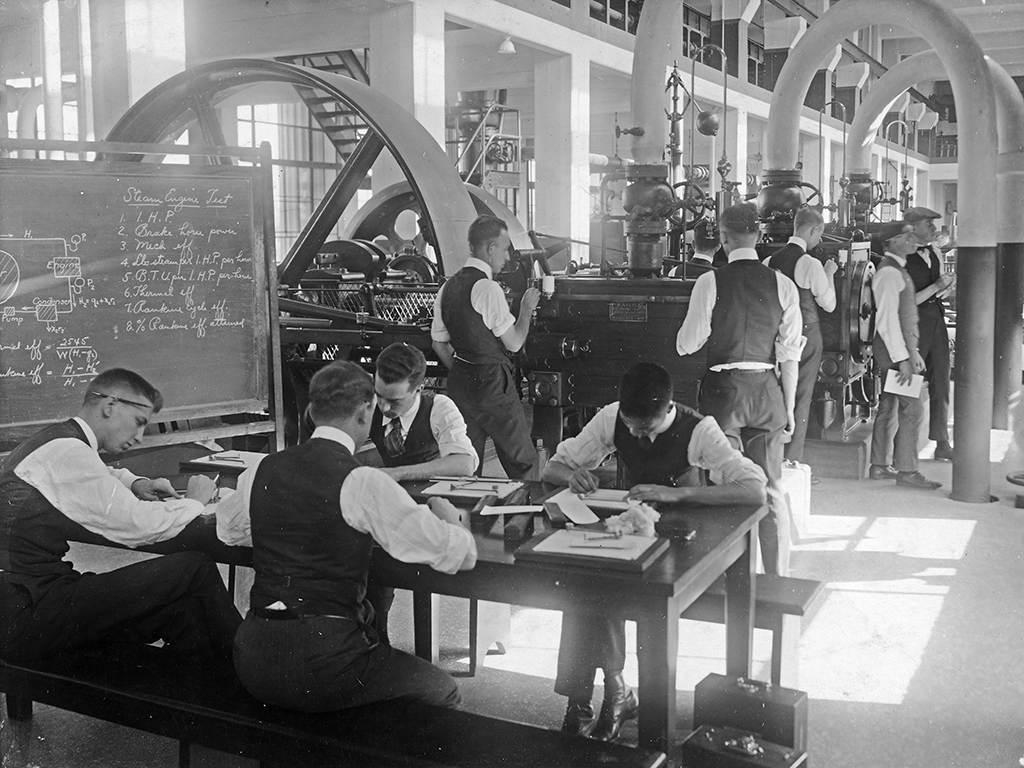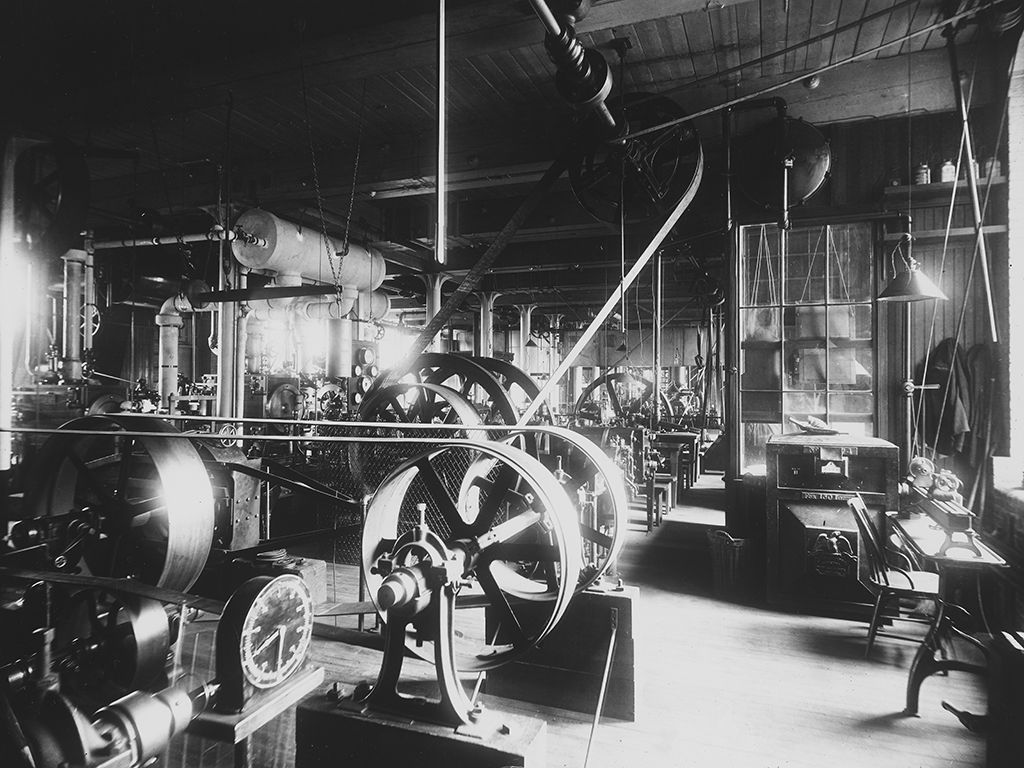Full Steam Ahead
MechE’s first laboratory set the stage for department’s legacy in thermal sciences and energy conversion and a host of other innovation happening today
"That first lab was, indeed, the Steam Lab," says John Hart, the Class of 1922 Professor and Head of the Department of Mechanical Engineering. "It laid the foundation for thermal engineering in MechE, catalyzing a legacy of fundamental discoveries and pivotal technologies in thermal sciences and energy conversion that continues today."
 A photo from the MIT archives labeled “Steam Engine Test” and “MIT Steam and Hydraulic Lab” date unknown. Credit: MIT Museum
A photo from the MIT archives labeled “Steam Engine Test” and “MIT Steam and Hydraulic Lab” date unknown. Credit: MIT MuseumThe Steam Lab was built with a gift from a local businessman, Mr. George Basil Dixwell. An account of this early history written in the 1940s by an author identified as Mr. Mooney notes that Dixwell had studied the steam engine and wanted independent experiments to test his conclusions regarding the value of superheated steam in preventing cylinder condensation.
“This was at that time a subject of technical dispute and of great economic importance,” writes Mooney. “Subsequent to the completion of Mr. Dixwell’s tests, many other tests were run for instructional and research purposes; the effect of the governing method upon the economy, and the effect of higher steam pressure upon the economy were among the matters investigated.”
The 1876 MIT Course Catalog describes the space as one “fitted with Steam Boilers, Superheaters, Engine, Calorimeter, Indicators, Pressure Gauges, Thermometers, and all the usual apparatus for producing and using steam, and for testing its nature and action.”
As the laboratory work developed, the boilers and engines used for heating and ventilating the building, and for driving the ore dressing machinery in the metallurgical laboratory were made available for testing. The lab was used by both engineering and physics students. The course in physics, Mooney writes, included “tests of engines and boilers; evaporation per pound of coal; measurement of power; transmission and absorption dynamometers; coating of steam pipes; friction of belts and pulleys; strength of materials.”
In 1883, when Whitaker retired, Gaetano Lanza, then head of the Department of Theoretical and Applied Mechanics, also became head of mechanical engineering. New instructors, including Cecil H. Peabody, joined MechE. Peabody transferred from Applied Mechanics, joining the department as Assistant Professor of Steam Engineering. Not only was he the first faculty member to be specifically designated as a professor of heat engineering, but the legacy of his contributions includes the creation of two significant MIT programs.
In his first year, Peabody helped establish course options in Marine Engineering, Locomotive Engineering, and Mill Engineering. In his first two years, Peabody produced text and data compilations to describe heat engineering instruction in thermodynamics that endured with little change for the next fifty years. He would go on to launch the Department of Naval Architecture and Marine Engineering in 1893, which would remain a separate department for over a century before rejoining MechE as Ocean Science and Engineering in 2005.
MIT’s first undergraduate courses in aeronautical engineering also grew out of Peabody’s steam turbine program. In 1909, U.S. Naval Academy graduate Jerome C. Hunsaker enrolled in MIT’s graduate program in naval construction. While studying, he developed a fascination with aeronautical literature and quickly became interested in aviation. In 1933, Hunsaker became head of mechanical engineering then, under Hunsaker’s leadership, in 1939, Aeronautics became a distinct department.
 A photo from the MIT Archives labeled “Building A with Corliss Engine in shot,” date unknown. Credit: MIT Museum
A photo from the MIT Archives labeled “Building A with Corliss Engine in shot,” date unknown. Credit: MIT MuseumA New Campus
By 1890, Heat Engineering was well-established as a major field of instruction. When MIT moved from the Back Bay to Cambridge in 1916, a new Steam Laboratory was built. This new lab, which occupied a multi-level space in Building 3, was equipped with steam engines of all types, including the Corliss engine, an enormous steam engine patented in 1849 fitted with rotary valves and variable valve timing.
During this time, the mechanical engineering department was headed by Professor Edward Furber Miller. Miller, like Whitaker, had a significant interest in heat engineering. Miller joined MIT as a professor of steam engineering in 1892. He took over as department head in 1911, and held the post until his death in 1933.
Courses in refrigeration, power plant construction, explosion engines, ventilation, automotive engineering, marine engineering, aeronautics, and more, all grew out of instruction in the heat engineering area. As new courses were introduced, new and separate laboratories were created to accommodate these new investigations.
According to a biography written in 1933 by an anonymous author and held in the archives of the MIT Museum, Miller was “largely instrumental in the development of the laboratories of the Mechanical Engineering Department from the modest beginnings in the basement of the Rogers Building to the present extensive equipment in ten or more laboratory divisions now under the Department.”
Some of these labs are still operating today, though their names and research areas have evolved with the times. In 1933, Professor C. Fayette Taylor, a pioneer in the development of the internal combustion engine, left his post in the Aeronautical Engineering Department to join Mechanical Engineering as a professor and director of the new Sloan Laboratory for Aircraft and Automotive Engines. Today, the Sloan Automotive Laboratory uses physics-based modeling, experiments, and data-driven machine learning modeling together to make internal combustion engines more sustainable.
The Heat Measurements Laboratory, which had been part of the Physics Department, transferred to Mechanical Engineering in 1934. MechE had long sent students to use this lab, and Physics was increasingly moving toward the subatomic realm. This laboratory, founded in the 1870’s, supplied valuable instruction in heat measurement techniques and was an important source of data on heat transmission coefficients. Today, the Rohsenow Kendall Heat Transfer Lab is home to research in transport phenomena and energy conversion processes for solar energy, fresh water supply, critical materials recovery, solid state transport, nanotechnology, and phase change systems.
By the late 1940’s, with a lot of the Steam Laboratory equipment having outlived its usefulness and with growing pressure for space in Institute buildings, much of the large steam and hydraulic equipment was removed to make space for new research and innovation, but the legacy of this important space lives on.
Heat Transfer Today
“The founding vision of MIT was that it would be, not a university, but an Institute of Technology where people learn the science and practical skills to make, build, invent, and maintain new technologies, all to support societal advancement,” says John H. Lienhard V, the Abdul Latif Jameel Professor of Water and Mechanical Engineering, who has written extensively about the history of heat engineering and MechE at MIT.
“We tend to work at the leading edge as much as we can,” he says. “Being good at solving a problem that lots of other people know how to solve is great, but it doesn’t break new ground – so we’re often asking ‘what is the emergent question that we can tackle.’”
Work on steam engines was important at the time of MIT’s founding because steam engines were widespread. There was a lot to be done both in designing them and in making them operate safely. As steam technology advanced, and improved designs and safety measures were adopted, attention turned to other pressing issues – from liquid-fueled engines, to gas liquefaction and low-temperature refrigeration, to nuclear power, along with a host of other topics.
“Our attention in this department remains on problems that have social and economic impact,” says Lienhard. “We ask, ‘How are we going to make the world a better place?’”
Lienhard found his own answer to that question with efforts to address water treatment. In the mid-2000s, leaning into his expertise in thermal engineering and transport phenomena, his team refocused work to address the problem of clean water supply and scarcity, particularly around desalination technologies.
“We were able to take ideas we developed here, in the Rohsenow Kendall Lab, and move them out into industrial practice where they’ve had a very big impact,” he says. “That’s what we can do as researchers, students, professors – when we see something that’s important, and we know we can go after it, we have the ability to change the world.”
Gradiant, a company spun out from this work, now operates in twelve countries and employs over 1,200 people worldwide.
The account by Mr. Mooney, along with a detailed history of the Rohsenow Kendall Heat Transfer Laboratory from 1870 to 1992 written by John H. Lienhard V, the Abdul Latif Jameel Professor of Water and Mechanical Engineering, is available on the RK Lab website at rklab.mit.edu. (rklab.mit.edu/heatengr.html)
Although unconfirmed, Lienhard suspects Mr. Mooney is David A. Mooney, SB 1934. Mooney wrote textbooks on thermodynamics and heat transfer in the early to mid 1950s and also appears in the 1950 MIT Bulletin as an Assistant Professor of Mechanical Engineering.